Demolition Contractors Larkspur
Top Building Demolition in Larkspur
Receive multiple Demolition Company Near Me quotes for your project today! Compare profiles, reviews, accreditations, portfolio, etc... and choose the best service.

Earth Basics Contracting Corporation
55 reviews3010 E. Miraloma Ave, Anaheim, 92806, USEarth Basics is Leading California & Texas in Site Balancing Earth Basics has managed more than 100 million square feet of earthwork ventures which include warehouses, retail centers, office complexes, food processing plants, manufacturing facilities, and more. Extensive in-house resources enable Earth Basics to tailor their services to meet and exceed their client’s needs and project objectives. Earth Basics efficiently coordinates their earthwork, focusing on time, cost and quality issues to guarantee results. Each project is unique, varying in scope, requiring customized designs, approaches, and applications. A systematic yet adaptable project management program is key for project success. By paying close attention to detail, quality is raised while simultaneously controlling costs. We anticipate and avoid problems rather than fixing them once they happen. No matter which direction your projects may take, Earth Basics stands ready to meet your earthwork needs. Levees & Flood Control Over the past decade, the Western US has seen the opposite end of the weather spectrum. The drought and the following weather systems that followed have changed our landscapes, damaged pre-existing infrastructure and cause millions in damage. Levees and flood control built before the drought may not be ready for the next waves of winter weather we have recently witnessed. In foresight flood control and storm water control has become a recent addition to our capabilities for all industries. This was natural to move for us, as we already offer civil engineering services, technology services, and equipment to perform this type of work, which is typically needed on very short notice. Earth Basics’ culture and customer service attitude allows for a quick response in a time of need, and we have what it takes to get the job done in a timely and cost efficient manner. Land Clearing/Demo Structure demolition, boulder removal, uprooting trees and vegetation. If you got it, Earth Basics can clear it out. Our unique earthwork experience in the business allows us to ‘value engineer’ the project, while planning and scheduling to account for all project obstacles from the start. Depending on your needs, Earth Basics can centralize the process and assume responsibility for everything from conceptual development through the design and construction. We know what works best, and can quickly and efficiently perform the task. Golf Courses The key feature of the world’s greatest golf courses is their grounds. Our expert crews and a specialized fleet of heavy equipment provide premium earthworks, excavation, and land clearing services to achieve even the most complicated elements of course design. From ground zero to C of O we do it all. Our estimating department uses cutting edge technology to produce accurate takeoffs and 3D modeling. With GPS Machine and Grade Control technology, ensuring we save your time and money on your project by getting it done faster, with incredible accuracy, and with minimal surveying costs to the property owner. Public Works Governments exist to protect the health, safety, and welfare of its citizens. America’s public works systems are part of the framework for that existence. Earth Basics infrastructure design can provide roads for safe travel, utilities for clean water, parks for recreation, and storm water management for protection against flooding. The quality of these infrastructure systems (roads, water distribution, wastewater collection, and storm drainage), impact the perception of the area and reflect its reputation. These types of projects have always been a great fit for the Earth Basics team. Housing Tracts Building a track home community is a large undertaking and land planning feet. Without the proper earthworks team, your project can be delayed or even worse encounter costly problems down the road. Our team at Earth Basics takes pride in our attention to detail with land development and controlled earthwork. Many subcontractors continuously praise and hope to start their work behind the earthwork's execution of work done on the preliminary subdivision plans, subdivision plat, and general grading. Testimonials Earth Basics leads in value added engineering while specializing in earthwork, excavation, heavy general engineering, site balancing, mass grading, ripping, scarification, moisture conditioning, dozing, 3D site modeling, land clearing, demolition, earthwork finishing, landfill closers and much more. Working throughout California, Arizona, and Texas, our highly trained staff develops innovative solutions to a variety of land and infrastructure needs in both the private and public sectors. Our team works in tandem with civil and soils engineer to establish balanced job sites during the essential preliminary stages of construction and site development. It is a common fact that most contractors prefer to start their work after Earth Basics develops perfected building pads.
- Services
- Why Us?
- Testimonials
- Gallery
Get Quote
KR Land Development LLC: Land Clearing and Site Prep
516 reviewsOrange, USAbout KR Land Development At KR Land Development, our mission is to transform natural landscapes into safe, sustainable, and accessible spaces. With a deep respect for the environment and a commitment to efficiency, we provide expert land clearing services that pave the way for responsible land development. Our goal is to balance the needs of our clients with the preservation of nature, delivering innovative solutions that create a harmonious coexistence between humanity and the land. We are dedicated to improving the accessibility, safety, and utility of our clients’ properties while minimizing our impact on the environment. By aligning cutting-edge technology with eco-conscious practices, we aim to be leaders in the industry, leaving a legacy of well-cleared land and a healthier planet for future generations. Ready to Get Started On Your Land Clearing Project? We've Got You Covered! If you are looking to get started on your next land clearing project, we are here to help! KR Land Development offers free consultations to every client that is interested in our land clearing or property services. We are licensed & insured, protecting our clients and their property at all times throughout the land clearing process.
- Services
- Why Us?
- Gallery
Get Quote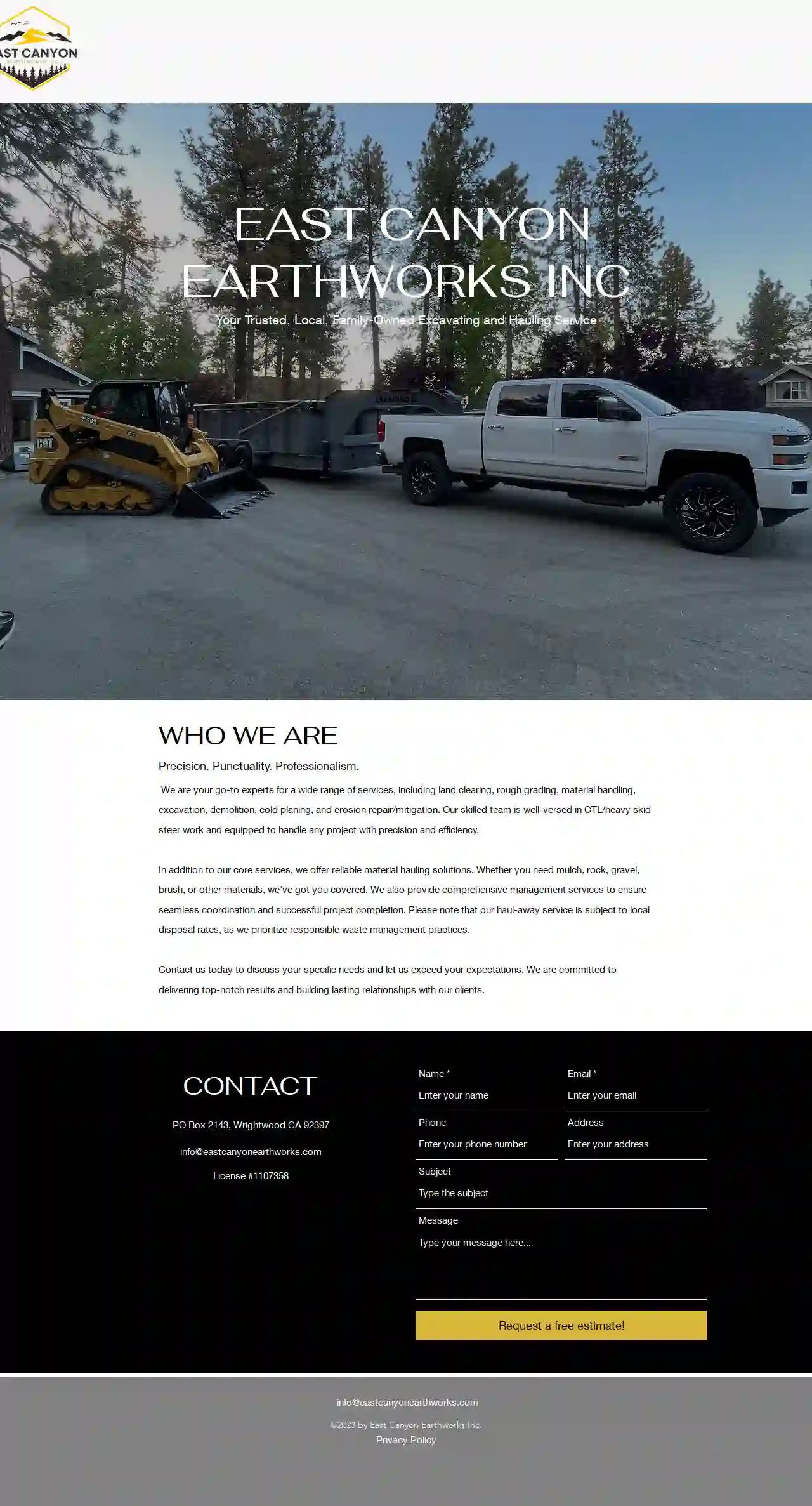
East Canyon Earthworks Inc
54 reviewsPO Box 2143, Wrightwood, 92397, USEAST CANYON EARTHWORKS INC Your Trusted, Local, Family-Owned Excavating and Hauling Service WHO WE ARE Precision. Punctuality. Professionalism. We are your go-to experts for a wide range of services, including land clearing, rough grading, material handling, excavation, demolition, cold planing, and erosion repair/mitigation. Our skilled team is well-versed in CTL/heavy skid steer work and equipped to handle any project with precision and efficiency. In addition to our core services, we offer reliable material hauling solutions. Whether you need mulch, rock, gravel, brush, or other materials, we've got you covered. We also provide comprehensive management services to ensure seamless coordination and successful project completion. Please note that our haul-away service is subject to local disposal rates, as we prioritize responsible waste management practices. Contact us today to discuss your specific needs and let us exceed your expectations. We are committed to delivering top-notch results and building lasting relationships with our clients.
- Services
- Why Us?
- Gallery
Get Quote
Big Bore Drilling
4.828 reviews1522 W Pine, Fresno, 93728-1211, USWelcome To Big Bore Drilling Certified Septic & Hydroflushing Family owned and operated, since 1959, Big Bore Drilling has been providing septic system installation, pumping, repairs and certifications. We also provide hydro-flushing/hydro-jetting as well as boring & drilling services. Call today for a fast and free phone quote. We are located in Fresno California and service Fresno county, Clovis, Madera County, and surrounding mountain areas. Don’t put off a job that we make easy, affordable and delivered with quality. Our Services SEPTIC SYSTEM INSTALLATION & REPAIR SEPTIC TANK PUMPING TEST HOLES DRILLING LEACH LINES SEPTIC REPAIR DRAIN WELLS LIFT STATIONS ENGINEERED SEPTIC SYSTEM INSTALLATION CITY SEWER HOOK-UPS & REPAIR SEPTIC INSPECTIONS HYDROFLUSHING VACUUM DEBRIS REMOVAL HYDRO EXCAVATION
- Services
- Why Us?
- Testimonials
- Gallery
Get Quote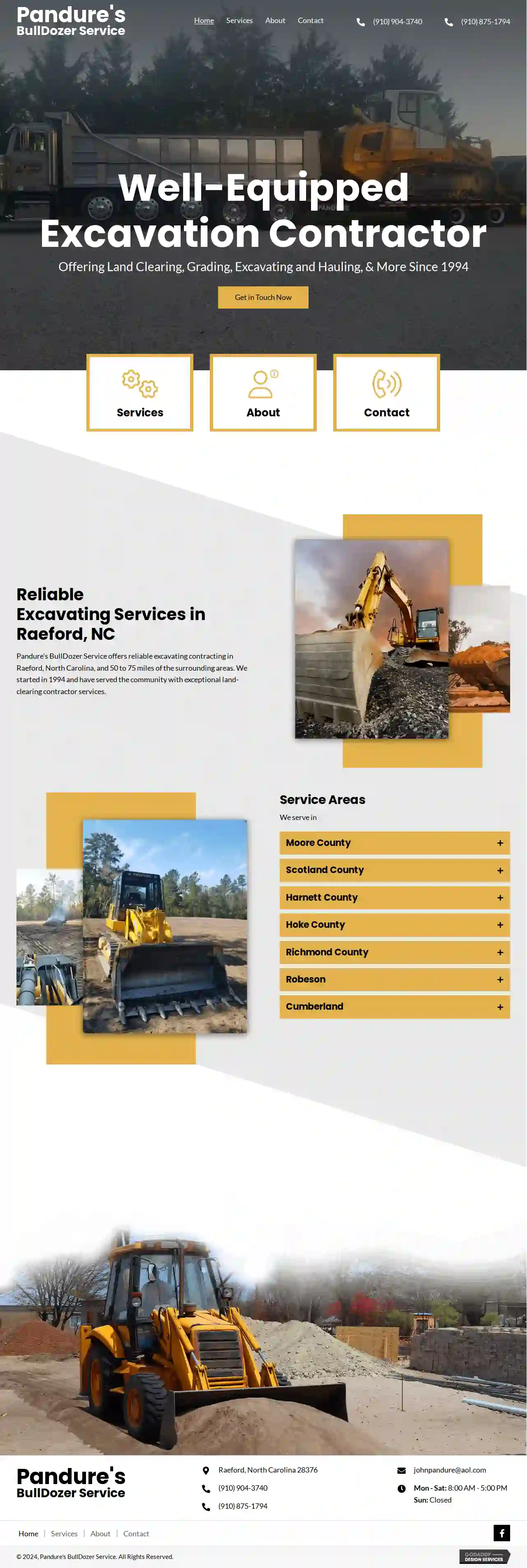
Pandure's BullDozer Service
58 reviewsRaeford, 28376, USPandure's BullDozer Service: Your Trusted Excavation Partner Pandure's BullDozer Service is a family-owned and operated excavation and land clearing specialist based in Raeford, North Carolina. We've been serving the community since 1994, providing reliable and professional services for all your land clearing, grading, excavating, and hauling needs. Our team is comprised of skilled professionals with decades of experience in the industry. We are committed to delivering seamless, safe, and trustworthy services, always prioritizing transparency and working within your budget. Whether you need land leveling for a new construction project, demolition work to clear an existing structure, or expert grading and excavating services, we have the expertise and equipment to handle it all. We are proud to serve a wide range of clients, including builders, developers, and homeowners in Raeford and the surrounding areas. At Pandure's BullDozer Service, we are dedicated to providing exceptional customer service and exceeding your expectations. Contact us today to discuss your project and let us help you bring your vision to life.
- Services
- Why Us?
- Testimonials
- Gallery
Get Quote
ACI - Abate Construction, Inc
4.69 reviews3504 Standard Street, Suite 6, Bakersfield, 93308, USQuality Commercial and Residential Renovations and Remodeling Serving Kern County, CA CALL FOR A FREE ESTIMATE Professional Commercial and Residential Renovation and Remodeling Services Abate Construction, Inc. is a veteran and locally owned and operated general contractor. We are bonded, insured, and licensed to work in both CA and AZ. We are located in Bakersfield, CA, and proudly serve commercial and residential customers in Kern County, including Bakersfield, East Kern, Delano, Oildale, Westside, Ridgecrest, Wasco, Greenfield-Panama, Rosamond, Lamont, and the surrounding areas. We offer free estimates for all our jobs. Let Us Help You Enhance the Beauty and Functionality of Your Home or Business We are your local company – we have over 13 years of experience working in this area of CA. We are familiar with the communities, homes, and permits required to work on any home or business renovation project. Our technicians work diligently to provide you with comprehensive services to maintain or create a home or business that you can be proud of. Our renovation projects can help you enhance the beauty and functionality of your property. About Abate Construction, Inc. Abate Construction, Inc. is dedicated to providing award winning construction service for all projects. Our success as a business is based on a simple and time proven approach. We listen to our client’s needs and understand their expectations. We ensure to exceed your expectations by utilizing the resources from our seasoned staff. We work in partnership with owners, architects, subcontractors, and engineers to deliver results. Abate Construction, Inc. delivers the best cost to quality ratio for each project. We specialize in helping the owner select cost-effective alternatives to maximize value. We Are Committed to Helping You Abate Construction, Inc. has been recognized as one of Bakersfield's premier residential and commercial contracting firms for the past 6 years. Founded with core values of providing professional construction services, high-quality cost-efficient buildings, and on time delivery, we have successfully developed reliability and performance-based relationships with our clients. Organization and good communication are fundamental in our customers’ satisfaction. With over 13 years of experience in the Bakersfield area, we can meet all your construction needs, including remodels, additions, new construction, job management, and consulting.
- Services
- Why Us?
- Testimonials
- Gallery
Get Quote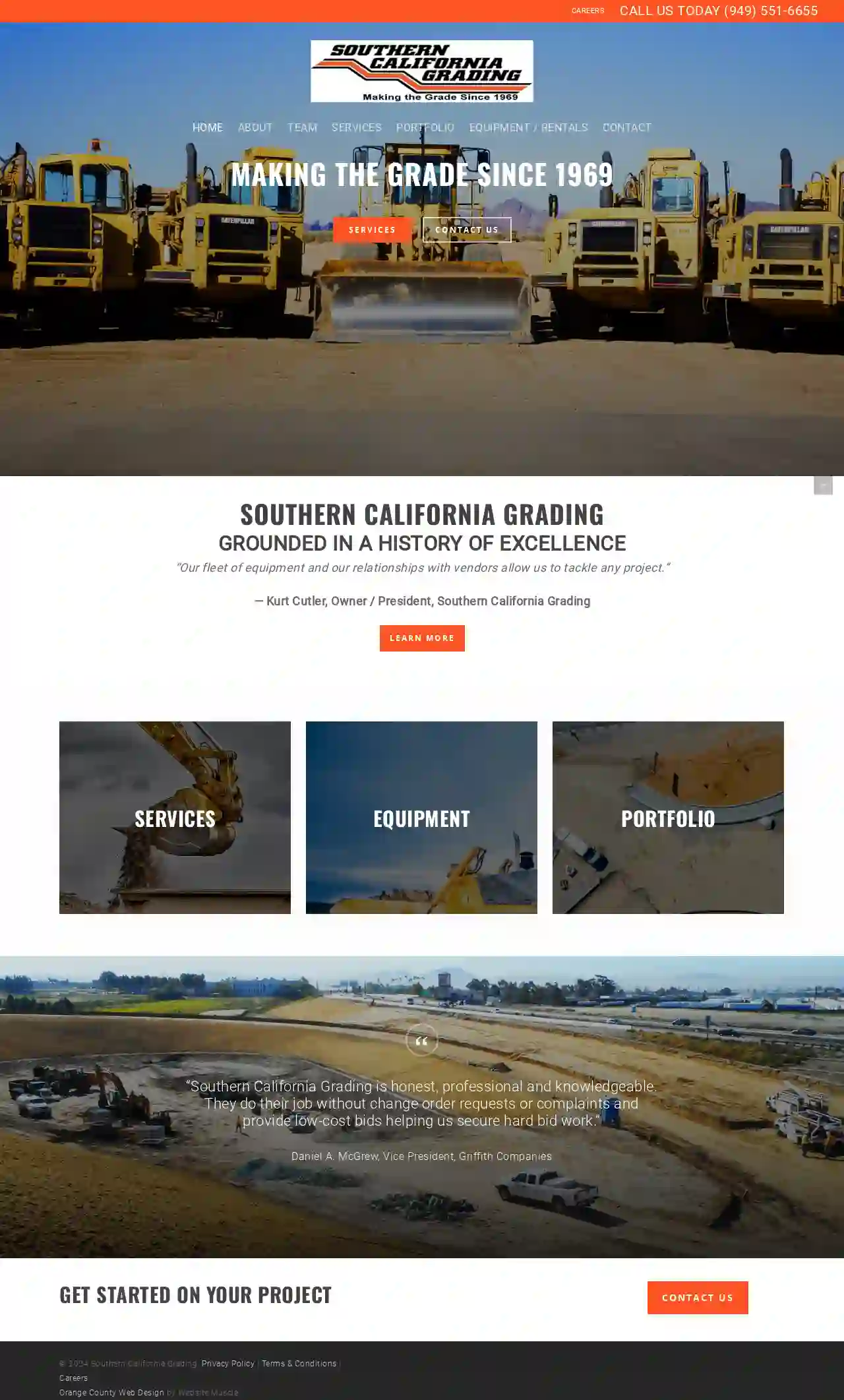
Urban Irvine Construction
56 reviewsSuite A, 16291 Construction Circle East, Irvine, 92606, USGrounded in a History of Excellence Southern California Grading was founded in 1969 by Bob Cutler and Bob Kehrer—two friends with extensive hands-on engineering and earthwork experience. In our early days, when Orange County was just starting to grow, we forged strong relationships with developers like the Irvine Company. Successful projects ranging from commercial ventures to developing new roads made Southern California Grading essential to bringing people and businesses to Irvine. These efforts began decades-long relationships with our clients and peers in the construction community. A Legacy of Teamwork and Mutual Respect Based in Irvine, California, Southern California Grading is still family-owned, and we pride ourselves on the core values of teamwork and mutual respect. Over the years, we have developed strong relationships with many clients and devoted employees. Some have been with us for over 25 years. Southern California Grading at a Glance $25 million in annual revenues Bondable and insured with an A+ rating Banks with one of the largest U.S. financial institutions Owns and rents its own fleet of heavy equipment Diverse market expertise Our Commitment to Excellence Our core principles of integrity, respect, responsibility and hard work have made us a premier provider of grading and construction services since 1969. We enjoy the challenge of navigating the ups and downs of our industry by focusing on client needs and adapting to industry advancements. A Firm Foundation for Success Today, Southern California Grading has a long history of successful projects throughout California. We’re proud of our reputation as a company that reliably provides a firm foundation for even the most complex building projects. Our experienced employees, technologically advanced equipment, and proven procedures provide assurance that the project will be completed on-schedule, within budget and done right, the first time.
- Services
- Why Us?
- Accreditations
- Gallery
Get Quote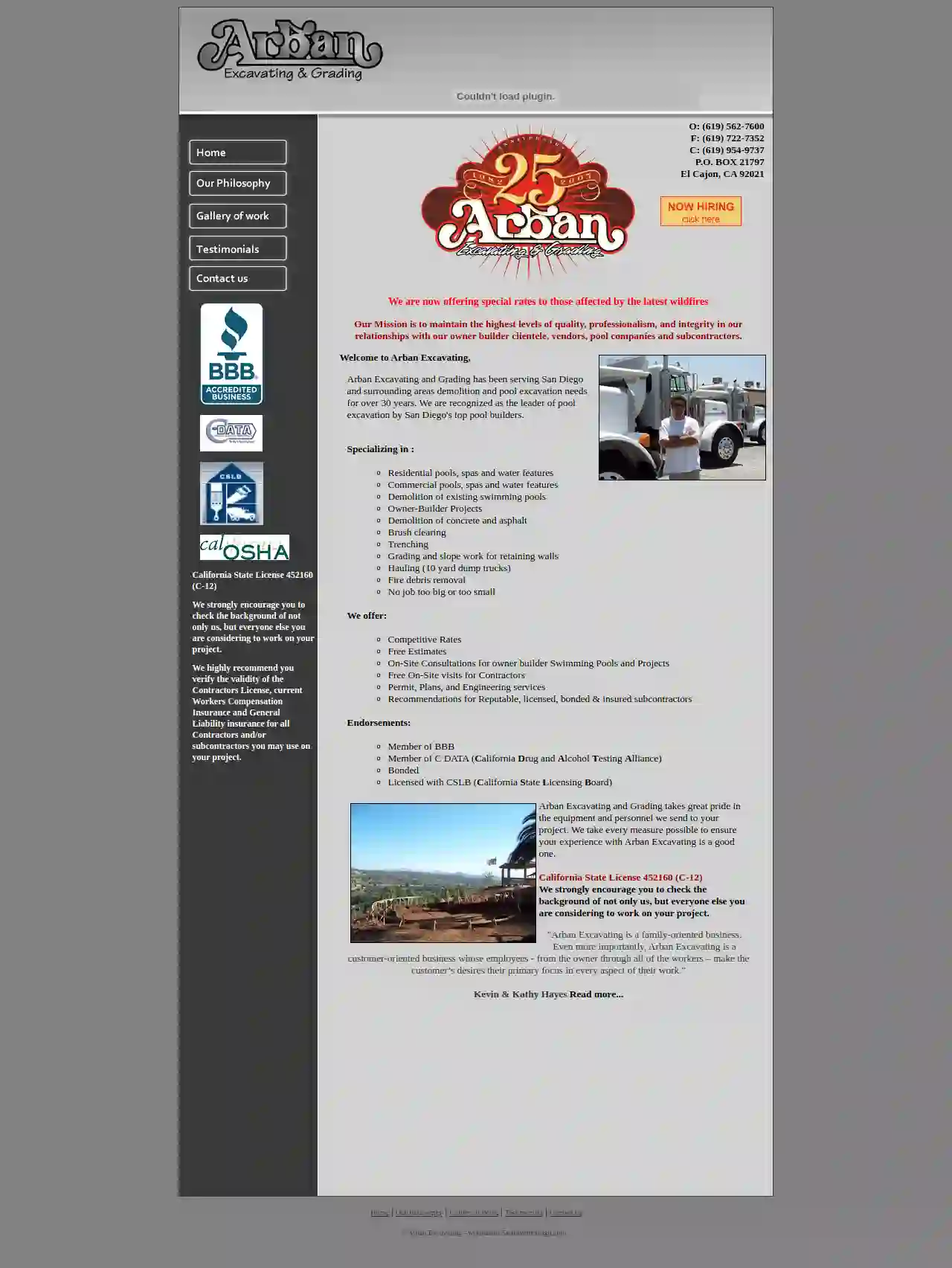
Arban Excavating & Grading
51 reviewsP.O. BOX 21797, El Cajon, 92021, USWelcome to Arban Excavating Arban Excavating and Grading has been serving San Diego and surrounding areas demolition and pool excavation needs for over 30 years. We are recognized as the leader of pool excavation by San Diego's top pool builders. Our Mission is to maintain the highest levels of quality, professionalism, and integrity in our relationships with our owner builder clientele, vendors, pool companies and subcontractors. Arban Excavating is a family-oriented business. Even more importantly, Arban Excavating is a customer-oriented business whose employees - from the owner through all of the workers – make the customer’s desires their primary focus in every aspect of their work. We strongly encourage you to check the background of not only us, but everyone else you are considering to work on your project. We highly recommend you verify the validity of the Contractors License, current Workers Compensation Insurance and General Liability insurance for all Contractors and/or subcontractors you may use on your project.
- Services
- Why Us?
- Testimonials
- Gallery
Get Quote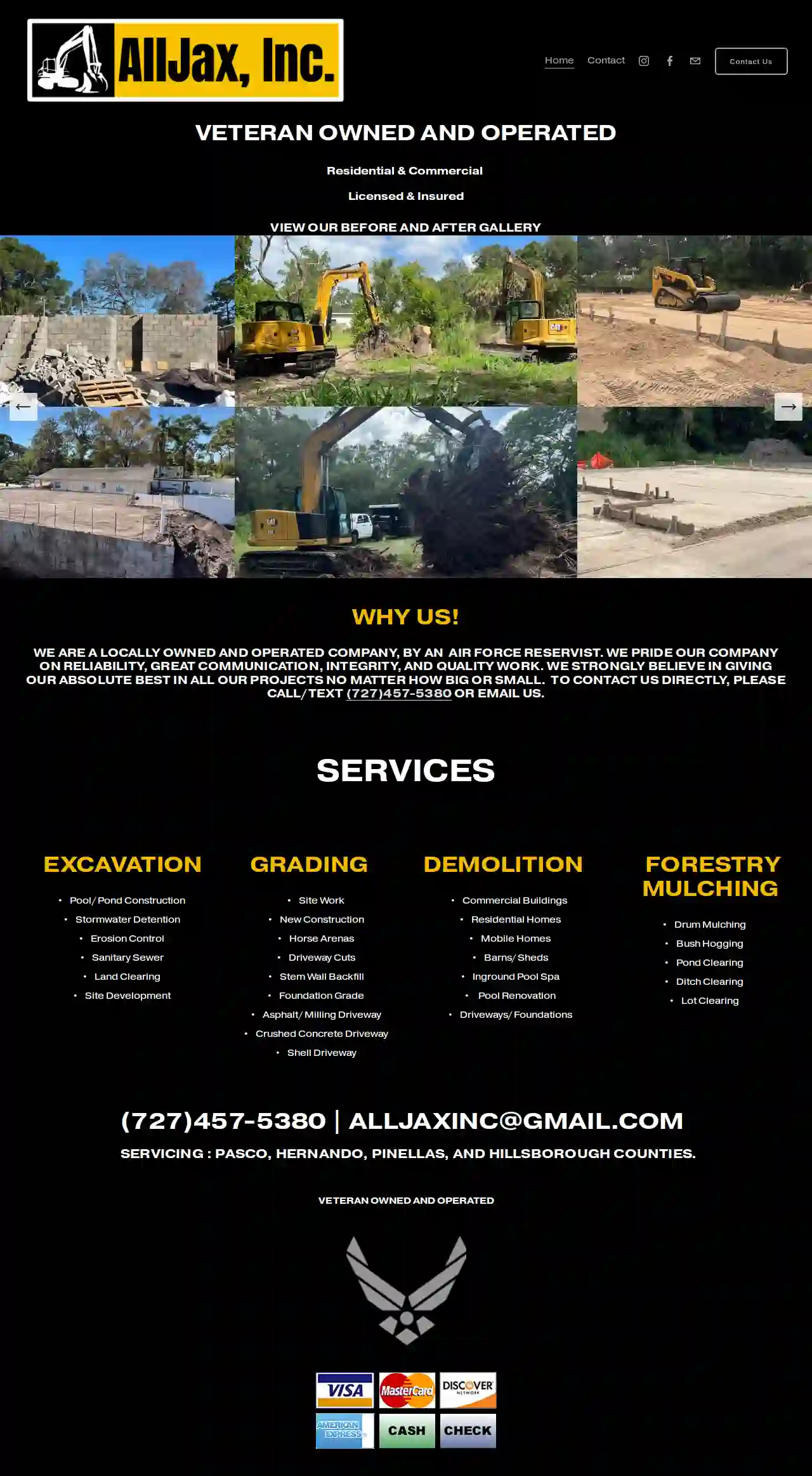
AllJax Inc Excavation, Forestry Mulching & Pond Clearing
4.935 reviewsDavis, USAllJaxInc is a locally owned and operated company, run by an Air Force reservist. We take pride in our reliability, excellent communication, integrity, and high-quality work. We are committed to delivering our best on every project, big or small. We are dedicated to providing exceptional service to our clients in Pasco, Hernando, Pinellas, and Hillsborough Counties. Our team is experienced in a wide range of services, including excavation, pool and pond construction, stormwater detention, erosion control, sanitary sewer, land clearing, site development, forestry, demolition, and grading. We are fully licensed and insured, and we are proud to be a Veteran Owned and Operated business. To contact us directly, please call/text (727)457-5380 or Email Us.
- Services
- Why Us?
- Gallery
Get Quote
Coates Dirt Works LLC
513 reviewsOrange, USWe'll Get You Back On Track Coates Dirt Works offers a variety of excavation services in Volusia County, Florida, including: Land Clearing Dirt Excavation and Removal Debris Removal Demolition Bobcat Services Large Landscaping Projects Large Animal Burial on Your Land Drainage Culverts Shell Roads Concrete Removal Call for a free estimate! (three-eight-six) 266-9479 or email [email protected] We would be happy to discuss your project needs and arrange to give you a free estimate.
- Services
- Why Us?
- Gallery
Get Quote
Over 22,076+ Excavation Companies on our directory
Our excavation experts operate in Larkspur & beyond!
ExcavationHQ has curated and vetted the Best Excavation Contractors in and around Larkspur. Find a top & reliable pro today.
Frequently Asked Questions About Demolition Contractors
- Project Assessment: The demolition contractor evaluates the structure, site conditions, and project requirements.
- Permitting: Obtain necessary demolition permits from local authorities.
- Site Preparation: Secure the site, disconnect utilities, and remove any valuable or reusable items.
- Hazardous Material Abatement: Professionally remove asbestos, lead paint, or other hazardous materials if present.
- Demolition: Execute the chosen demolition method, bringing down the structure safely and efficiently.
- Debris Removal and Site Cleanup: Sort, process, and dispose of demolition debris responsibly. Clean up the site to prepare it for future use.
What is the difference between demolition and deconstruction?
Demolition: Typically involves bringing down a structure quickly and efficiently, often using heavy machinery and potentially explosives. The primary goal is to clear the site.
Deconstruction: Focuses on carefully dismantling a building piece by piece to salvage reusable materials. It prioritizes minimizing waste and environmental impact, often involving manual labor and specialized tools.
The choice between demolition and deconstruction depends on the project's objectives, budget, and environmental considerations.
What are the steps involved in a typical demolition process?
What is asbestos abatement?
Do I need a permit for demolition?
What is the difference between demolition and deconstruction?
Demolition: Typically involves bringing down a structure quickly and efficiently, often using heavy machinery and potentially explosives. The primary goal is to clear the site.
Deconstruction: Focuses on carefully dismantling a building piece by piece to salvage reusable materials. It prioritizes minimizing waste and environmental impact, often involving manual labor and specialized tools.
The choice between demolition and deconstruction depends on the project's objectives, budget, and environmental considerations.
What are the steps involved in a typical demolition process?
- Project Assessment: The demolition contractor evaluates the structure, site conditions, and project requirements.
- Permitting: Obtain necessary demolition permits from local authorities.
- Site Preparation: Secure the site, disconnect utilities, and remove any valuable or reusable items.
- Hazardous Material Abatement: Professionally remove asbestos, lead paint, or other hazardous materials if present.
- Demolition: Execute the chosen demolition method, bringing down the structure safely and efficiently.
- Debris Removal and Site Cleanup: Sort, process, and dispose of demolition debris responsibly. Clean up the site to prepare it for future use.